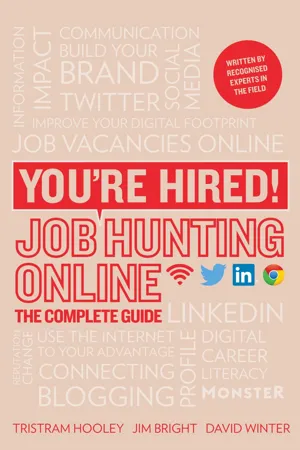![]()
1 CHANGE IS INEVITABLE – BE AN ADVENTUROUS EXPLORER!
Change is inevitable, except from a vending machine.
Our working lives are always changing. As the internet becomes an increasingly central part of work, it speeds up these changes.
In this chapter we share with you some tips about how to change your career plans, and changing your approach to make the most of this ever-changing world. We advise you to embrace the fast-moving reality of online careers and to keep on top of the (sometimes) bewildering changes happening within social media. If you are particularly interested in how change influences our careers, and want to read more deeply about this, you may wish to have a look at the book The Chaos Theory of Careers by Robert Pryor and Jim Bright.ii
This chapter will cover:
•making and remaking career plans
•being positive about change
•learning to adapt
•using new software and tools
•finding the time for social media.
Shift happens!
It is a reality of modern working life that shift happens. Change is occurring everywhere, driven by technological and scientific advances, changing tastes and expectations, political decisions and pressures, economic booms and busts.
In a few short decades from the 1970s and ’80s we have gone from the aerogram (air letter) being the primary way to communicate with people in far-off lands to emails, instant messages, Skype and tweets. In between, we had the fax, the technological equivalent of the boy band – been, gone and forgotten.
Speeded up communication, and the mind-boggling possibilities for new interconnections between people, companies and nations, has led to sudden and unpredictable outcomes. When things get very connected, unpredictable things happen. Think about a Rubik’s cube, the three-dimensional colour block puzzle. Have you ever tried to get one side of the cube all the same colour, only to find in doing so you have messed up another side you had previously worked on? The Rubik’s cube only has 54 little coloured tiles, but because they are connected to each other, it turns out that there are 43 quintillion combinations of the cube! And the Rubik’s cube is simple compared with the interconnections on the internet!
Image created by Booyabazooka and reproduced under a Creative Commons Attribution-Share Alike 3.0 Unported license (https://creativecommons.org/licenses/by-sa13.01).
What has this got to do with career plans? This highly connected world is one in which change happens quickly, unpredictably and sometimes dramatically. This means we need to be prepared to change our career plans. We have to be prepared to weather unexpected turbulence on the way to our goals. Setting goals is fine, but don’t be surprised if the goal posts keep moving. If your goal in 2005 was to invest a lot in a marketing strategy for what was then the most popular social media site, MySpace, within three years you would have seen MySpace surpassed by Facebook. If you’d decided to buy MySpace in 2005 it would have set you back £378 million. Eleven years later you would have turned that investment into a puny £35 million. Not many career plans have a goal of losing £29 million a year for over a decade. Things change, so that means you need to learn not only how to make a plan but how to change that plan.
Ashwin and Alvey went into business together, opening an upmarket café restaurant. After a slow start and many long hours of hard work, the business began building. Things really took off, after an anonymous online review in 2007 raved about their food. Their plan had always been to build a brand, and a chain of restaurants. With several years of steadily increasing profitability, they had no problem in obtaining a series of bank loans, and quickly opened a further four restaurants. Then the credit crunch hit in 2008. Ashwin and Alvey’s customers stopped eating out at the very time the banks called in their loans. In 2009, they declared bankruptcy. What they learned along the way was very valuable, and both men found work, Ashwin as a restaurant manager, and Alvey as a chef. While catering for a private corporate party, Alvey met a film financier, and one thing led to another, and he now runs an international film-set catering operation, travelling the world and serving famous actors and directors.
Making and remaking career plans
Once upon a time, we were told that to have a successful career we needed to write a career plan. A career plan set out what we were hoping to achieve and how we were going to get there. The more detailed plans might have even broken this down to a month-by-month set of actions. When should you be applying for a promotion, moving to a new company and so on?
Plans can be useful as they help us to think through the direction that we want to move in and what might be involved in moving. But the problem with plans is that by the time a few months have passed, so much has changed. Perhaps the industry that you were interested in has experienced a major collapse (who’d have thought that the banks would hit so much trouble in 2008) or perhaps you’ve changed: got married, had a child or just decided that this job isn’t as much fun as you thought. In most cases, sticking rigidly to a career plan makes us less flexible and less able to make the most of opportunities. So, if career plans are not as useful we used to think, what is the alternative?
We need to develop what we call Planmanship skills. These are the skills to Revise, Abandon, Pause, Implement, Devise, Copy, Promote and Revive a plan – our RAPID-CPR model. Nobody teaches you how to do this. Until now.
Applying RAPID-CPR
Revising a plan. Plans need constant monitoring to see if they are still working. Generally we only monitor plans for progress, and our only remedy is to work harder. However, revising a plan requires us to consider the:
•destination
•route
•method of transport.
Questions to regularly ask about your career plan
•Is the destination still attainable from where you are now?
•Is there a better destination that you have discovered along the way?
•Is the route ahead clear? If not, are the barriers surmountable?
•Is there a better, faster, more efficient route?
•Is there a more ‘scenic’ route that will be more pleasurable or provide a richer learning experience?
•Is the way I am trying to get there the most appropriate?
•Should I be doing this on my own or should I enlist partners, colleagues or supporters?
•Should I ditch some underperforming partners, colleagues or supporters?
•What else should I be doing, or doing bet...

